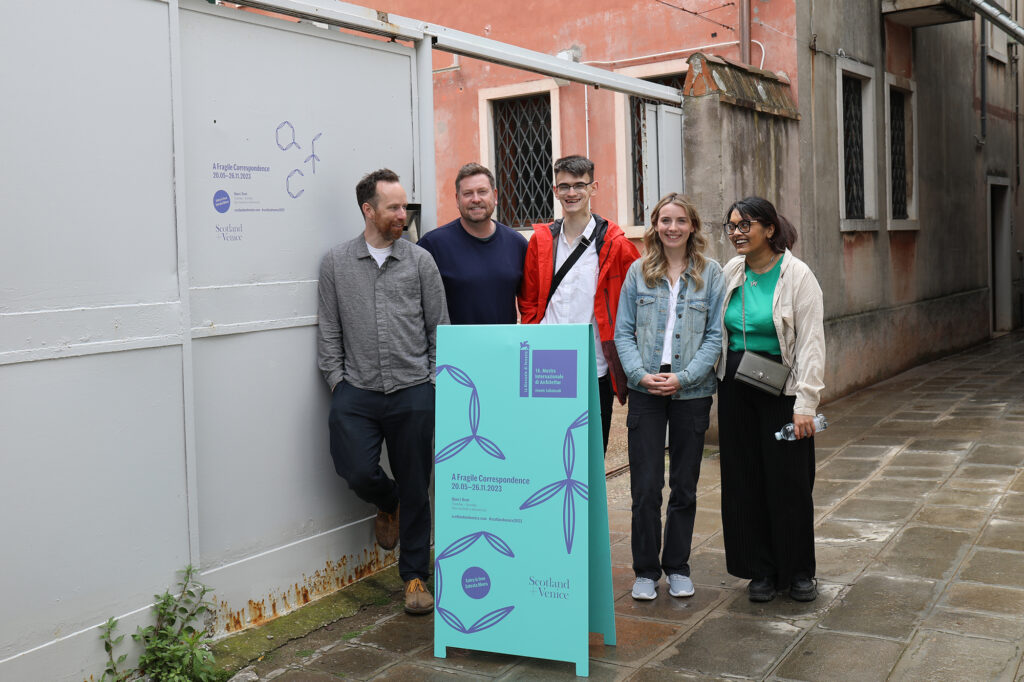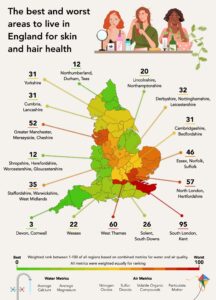Correspondence’ at 18th International Architecture Exhibition – La Biennale di Venezia

2023 is a great year for Scotland at the prestigious architecture exhibition in Venice, curated by Scottish-Ghanaian architect Lesley Lokko, with Scotland + Venice partnership commission A Fragile Correspondence by the Architecture Fringe, ism magazine and /other at _docks_cantieri cucchini, and Skye-based Dualchas, presenting at the festival exhibition hub, the Arsenale.
Highlighting cultures and languages that have a close affinity with the landscapes of Scotland, A Fragile Correspondence explores alternative perspectives and new approaches to the challenges of the worldwide climate emergency.
Taking inspiration from The Laboratory of the Future organised by La Biennale Architettura and curated by Scottish-Ghanian architect Lesley Lokko, writers, artists and architects, in correspondence with these landscapes, explore issues distinctly rooted in place but with global relevance to the cultural, ecological and climatic issues that we face.
Commissioned by the Scotland + Venice partnership and curated by the Architecture Fringe, -ism, and /other, A Fragile Correspondence will be on public show from 20 May – 26 November 2023 at the _docks_cantieri cucchini, S. Pietro di Castello, 40, 30122 situated between the festival hubs, the Giardini and Arsenale.
A journey across Scotland
From the forests around Loch Ness, the seashore of the Orkney archipelago, and the industrialised remnants of the Ravenscraig steelworks, the project takes us on a journey through three Scottish landscapes across the Highland, Island and Lowland.
In Loch Ness with the Highlands as the genesis for modern, romanticised world tourism, the exhibition explores how internationalised capital and commercial extraction affects the biodiversity, cultural identity and environmental sustainability of the land in a local context.
In Orkney the work examines how the local population have for centuries negotiated the forces of nature, in particular the dynamic and powerful sea, as an example of an evolving relationship between people and place anchored in a deep understanding of the natural environment and steeped in community resilience.
At Ravenscraig, in the Lowlands, the exhibition presents the contemporary landscape, often unseen as a moment between somewhere and nowhere, as a place of authenticity and a resurgent natural landscape.
Through these creative explorations, and by proposing a new lexicon of terms and definitions, the exhibition looks to see the potential in possible futures that sensitively work in correspondence with the land rather than simply upon it.
About the creative team
The project is a curatorial collaboration between the Architecture Fringe, ism, and /other. Their curatorial approach centres on a shared understanding and appreciation of diverse cultural nuance, lived experience, and a close reading of social, political, and environmental contexts.
The Architecture Fringe is a self-initiated non-profit volunteer-run organisation which explores architecture and its impact within our collective public life. -ism architecture magazine is an independent publication based in Glasgow with a desire for bold and critical reflection on the built environment and creating accessible writing for voices of diverse backgrounds. /other is a collective of POC (people of colour) creatives that centres the marginalised individual within architectural discourse.
Representing each collective is Neil McGuire and Andy Summers for the Architecture Fringe, Kristina Enberg, Amy McEwan, Aoife Nolan, Alissar Riachi for ism magazine, and Alyesha Choudhury, Carl C.Z. Jonsson and Mia Pinder-Hussein for /other (pronounced: slash other).
Exhibition participants include Dele Adeyemo, Prof. Donna Heddle, Aaron McCarthy, Frank McElhinney, Dr. Mairi McFadyen, Hamshya Rajkumar, Raghnaid Sandilands, and Dr. Amanda Thomson. Exhibition collaborators are Simon Forsythe for Lateral North, and Ann Louise Kieran for North Lanarkshire Council.
Visitor experience
Situated adjacent to the dock with open views to the canal and city beyond, the exhibition is arranged into four distinct areas with visitors being gently guided through the landscapes of Loch Ness, Orkney, and Ravenscraig before reaching the reading room and project lexicon.
Each landscape is introduced through chosen words and language with a bespoke research wall of archive and contemporary imagery, printed materials and artefacts. Large-scale monitors display specially commissioned films presenting the landscapes through poetic audio and moving image with contributions from the curatorial teams and exhibition participants.
The creative responses to the questions posed by A Fragile Correspondence are displayed throughout the exhibition and include artworks, photography, sculpture, installation work, film, audio and sound. Materials used within the exhibition’s presentation reflect aspects of the various landscapes in focus with timber supporting the work exploring Loch Ness, straw and a palette of natural materials helping to frame Orkney, and an emphasis on metalwork and the reflection of heat contextualising Ravenscraig.
A Fragile Correspondence culminates in the reading room which hosts the project lexicon and hosts a digital touchscreen interface where visitors are invited to interact with the text and resources to contribute their own words and descriptions for place, land and landscapes that are important to them.
Amanda Catto, Head of Visual Arts for Creative Scotland and Chair of the Scotland + Venice partnership, commented: “We are excited to see the distinctive work of the teams at Architecture Fringe, ism and /other come together to showcase Scotland’s dynamic thinking and creative excellence at La Biennale di Venezia. Taking audiences on a journey through the land and languages of Scotland, A Fragile Correspondence asks important questions about how we can learn from the past to reset our relationship with the natural world into the future. Responding to Lesley Lokko’s themes for La Biennale, the Scotland + Venice exhibition has been carefully designed to nurture new connections and spark opportunities for cultural exchange at one of the most significant platforms for Architecture in the world.”
Andy Summers, Co-Founder and Co-Director of the Architecture Fringe said: “The exhibition explores the site of the former Ravenscraig Steelworks, which at the time of its closure in 1992 was the largest hot strip steel mill in Western Europe. Ravenscraig’s current industrial landscape is commonly perceived through binary understandings of being between somewhere and nowhere, where its authentic contemporary state is often unseen. Our work here recognises Ravenscraig as a place of authenticity and value, as a resurgent natural landscape full of memory and stories. By looking differently we can start to see and recognise its future as a potential community asset – a site of leisure and environmental rebalancing.”
Co-founder of /other Carl C.Z. Jonsson has said: “The first of the three sites that visitors will explore in the Collateral Event space is the forest landscape surrounding Loch Ness. Images and associations conjured by the famous loch belie a complex reality of land ownership and extraction, that through time has evolved from the Highland Clearances to the farming of non-native tree species. The work of the Abriachan Forest Trust has provided the starting point for a reckoning with this reality, allowing us to explore alternative ways of seeing the land of this area that we hope will outlast the reductive and romanticised idea of the Highlands.”
Aoife Bláthnaid Nolan, Editor-in-Chief of -ism magazine, added: “It’s the people we have met in each location that contributed to this impact. Prof. Donna Heddle, director of UHI Institute for Northern Studies in Orkney unveiled to us the perpetual awareness that Orcadians have of their natural environment. Their day-to-day lives are intertwined with forces of nature, due to their exposed island landscape. Despite persistent tidal issues such as coastal erosion and flooding, they have learned to adapt to these through community means; an attitude Orcadians have since pre-history. Which sits alongside Aaron McCarthy, with work that positions language at the centre of Orkney’s vast sea and sky, questing what happens when we attempt to engage a historical and extinct language with modern minds.”
This will be the twentieth commission by the Scotland + Venice partnership (Creative Scotland, British Council Scotland, National Galleries of Scotland, Architecture and Design Scotland, V&A Dundee and the Scottish Government).
Since its founding in 2003, Scotland + Venice has been committed to delivering a learning and professional development programme, creating opportunities for over 150 students and early career practitioners to experience La Biennale and the international world of contemporary art first-hand. In 2023 the PDP programme also includes participants from organisations involved in the exhibition. Each participant is located in Venice for a four-week period, working together and undertaking research based on their professional or academic interests. With funding from Architecture and Design Scotland, with support from the British Council Scotland. The PDP programme participants are backed by 11 colleges and organisations:




